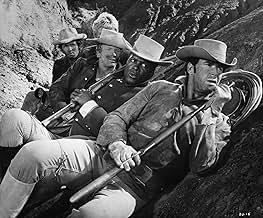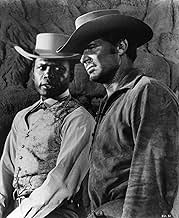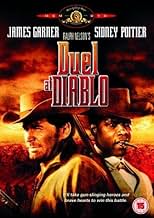PUNTUACIÓN EN IMDb
6,5/10
4,7 mil
TU PUNTUACIÓN
En territorio apache, un hombre busca al asesino de su mujer india y una ama de casa abandona a su marido, para unirse a la tribu de su amante apache.En territorio apache, un hombre busca al asesino de su mujer india y una ama de casa abandona a su marido, para unirse a la tribu de su amante apache.En territorio apache, un hombre busca al asesino de su mujer india y una ama de casa abandona a su marido, para unirse a la tribu de su amante apache.
- Dirección
- Guión
- Reparto principal
- Premios
- 1 nominación en total
Ralph Nelson
- Col. Foster
- (as Alf Elson)
Armand Alzamora
- Ramirez
- (sin acreditar)
Ralph Bahnsen
- Trooper Nyles
- (sin acreditar)
Timothy Carey
- Deputy Clem
- (sin acreditar)
Jeff Cooper
- Trooper Casey
- (sin acreditar)
Kevin Coughlin
- Norton
- (sin acreditar)
Robert Crawford Jr.
- Trooper Swenson - Bugler
- (sin acreditar)
Reseñas destacadas
A bloody, brutal Western where the action never stops.
First, the Bad (let's get that out of the way). Like all Westerns, the plot has its flaws -- with an Indian war party off the reservation they would not have sent a shipment of ammunition through a narrow canyon guarded by only one squad of green recruits on unbroken/partly saddle broken horses. But so what? In the classic Western Stagecoach the Indians would have shot the horses pulling the stage and then finished off the passengers as opposed to shooting at the people in the coach. Also, Sidney Poitier's silver vest remains immaculate throughout the long desert journey and several pitched battles.
However, the movie moves so fast that you never really have time to stop and remind yourself that you have to "suspend disbelief" to watch it.
Next, the Good. On one level, it's a classic cavalry vs. Indians story. But viewed through a different lens than in earlier Westerns; the Indians are shown with some perspective, if not total sympathy, which probably makes this one of the first Westerns to get beyond a one dimensional view of them. There are a variety of interesting subplots which flesh out the major characters and keep things twisting, turning, and moving along between the combat scenes. In fact, almost every one of the characters is angry about something, creating lots of tension between them. James Garner's character is looking for the men who raped and killed his (Indian) wife, Dennis Weaver's Will Grange is angry about almost everything, including that his wife was held captive by the Indians, Sidney Poitier's Toller (now a civilian) is mad that circumstances forced him to accompany the cavalry on this mission ....
Garner and Poitier give excellent performances and the other actors rise to the occasion, helping us forget that they are, in fact, Scottish or Danish.
At the end of the movie the various subplots are tied up and the issues are resolved with (in one case) a very surprising twist.
On top of that, you have a wonderful (almost superb, for this movie) Neal Hefti score, which always seems to correctly reflect the mood of the scene. It fits the movie even better because it makes heavy use of Western/military instruments: guitars, horns, drums, ....
Finally, the Ugly. There are some fairly graphic scenes here (although not exactly like in the Wild Bunch or Saving Private Ryan). The Apaches could torture with the best of them and some of that appears in this movie, although we're spared the close-ups.
All in all, I must say that this is one of my long time favorites. I hope you enjoy it as much as I do!!
First, the Bad (let's get that out of the way). Like all Westerns, the plot has its flaws -- with an Indian war party off the reservation they would not have sent a shipment of ammunition through a narrow canyon guarded by only one squad of green recruits on unbroken/partly saddle broken horses. But so what? In the classic Western Stagecoach the Indians would have shot the horses pulling the stage and then finished off the passengers as opposed to shooting at the people in the coach. Also, Sidney Poitier's silver vest remains immaculate throughout the long desert journey and several pitched battles.
However, the movie moves so fast that you never really have time to stop and remind yourself that you have to "suspend disbelief" to watch it.
Next, the Good. On one level, it's a classic cavalry vs. Indians story. But viewed through a different lens than in earlier Westerns; the Indians are shown with some perspective, if not total sympathy, which probably makes this one of the first Westerns to get beyond a one dimensional view of them. There are a variety of interesting subplots which flesh out the major characters and keep things twisting, turning, and moving along between the combat scenes. In fact, almost every one of the characters is angry about something, creating lots of tension between them. James Garner's character is looking for the men who raped and killed his (Indian) wife, Dennis Weaver's Will Grange is angry about almost everything, including that his wife was held captive by the Indians, Sidney Poitier's Toller (now a civilian) is mad that circumstances forced him to accompany the cavalry on this mission ....
Garner and Poitier give excellent performances and the other actors rise to the occasion, helping us forget that they are, in fact, Scottish or Danish.
At the end of the movie the various subplots are tied up and the issues are resolved with (in one case) a very surprising twist.
On top of that, you have a wonderful (almost superb, for this movie) Neal Hefti score, which always seems to correctly reflect the mood of the scene. It fits the movie even better because it makes heavy use of Western/military instruments: guitars, horns, drums, ....
Finally, the Ugly. There are some fairly graphic scenes here (although not exactly like in the Wild Bunch or Saving Private Ryan). The Apaches could torture with the best of them and some of that appears in this movie, although we're spared the close-ups.
All in all, I must say that this is one of my long time favorites. I hope you enjoy it as much as I do!!
Like the other reviewer of this movie, I, too, was a young child when I first saw this movie. It was around 1975 and it made quite an impression on me. My father, Bob Weissman, who loved the music in the film, first played the soundtrack for me. It is hypnotic and stirring -just excellent. The movie's storyline is not intricate, but what it lacks in depth, it makes up for with some suspense, good cinematography and of course, great music. James Garner is charismatic just like he is in "Support Your Local Sheriff" and Sydney Poitier, Dennis Weaver and Bibi Anderson fill their roles adequately. Overall, a good rental for a rainy (or snowy) afternoon or evening.
What terrific production values—that trek across a hellishly barren Utah desert had me off the couch, running for a water pitcher. And catch all those cavalrymen, Indians, and wild horses, enough for at least ten more westerns. Then there's the great James Garner to headline, along with a spiffy Sidney Poitier. So, why isn't this a top-notch horse opera, given such promising prospects.
For one thing, there's about ten sub-plots too many. Heck, just the ordeal across the desert should be enough for most westerns without over-crowding the storyline. Sure, the script is making a good point about racism with Ellen's half-Indian baby. But do we need the soap opera sub-plot with husband Dennis Weaver that's mainly a distraction. Then there's Poitier showing it wasn't just white guys who won the west. And, of course, the screenplay has to carve out a large enough role for a second headliner. Add to that Garner's search for whoever scalped his wife that is sort of tacked on at the end, and we've got enough plot material for three more features.
Sure, the movie's heart is in the right place. But messages are one thing, while merging them into a fluid narrative is another, and here the sub-plots add to the general problem of too much storyline clutter. The root of the problem, I expect, was hiring too many name stars, even if Travers and Andersson are known mainly to foreign audiences. Speaking of the cast, Garner's unusual skills are largely wasted in a role any number of imposing presences like Clint Walker could have easily handled.
And I never thought it would happen, but by about the twentieth skirmish across the desert, I actually got a little bored with all the repetitive stunts and endless shooting. 'More', it seems, is not always better, and I suspect the lesson is there can be too much action even in an action movie.
Anyway, I don't want to simply dismiss the movie because of its excesses since there are also a number of good touches (Chata gets some respect as a leader of his people, even though we see him as cruel), along with the generous production values. I'm just sorry the movie doesn't succeed better given its praiseworthy side.
For one thing, there's about ten sub-plots too many. Heck, just the ordeal across the desert should be enough for most westerns without over-crowding the storyline. Sure, the script is making a good point about racism with Ellen's half-Indian baby. But do we need the soap opera sub-plot with husband Dennis Weaver that's mainly a distraction. Then there's Poitier showing it wasn't just white guys who won the west. And, of course, the screenplay has to carve out a large enough role for a second headliner. Add to that Garner's search for whoever scalped his wife that is sort of tacked on at the end, and we've got enough plot material for three more features.
Sure, the movie's heart is in the right place. But messages are one thing, while merging them into a fluid narrative is another, and here the sub-plots add to the general problem of too much storyline clutter. The root of the problem, I expect, was hiring too many name stars, even if Travers and Andersson are known mainly to foreign audiences. Speaking of the cast, Garner's unusual skills are largely wasted in a role any number of imposing presences like Clint Walker could have easily handled.
And I never thought it would happen, but by about the twentieth skirmish across the desert, I actually got a little bored with all the repetitive stunts and endless shooting. 'More', it seems, is not always better, and I suspect the lesson is there can be too much action even in an action movie.
Anyway, I don't want to simply dismiss the movie because of its excesses since there are also a number of good touches (Chata gets some respect as a leader of his people, even though we see him as cruel), along with the generous production values. I'm just sorry the movie doesn't succeed better given its praiseworthy side.
Caught between Hollywood's traditional western genre and the revisionist western styles of the late 1960s and 1970s, Duel at Diablo seems both a little behind and ahead of its time. As an old-fashioned western, Duel at Diablo has traditional cavalry vs. Indian story line and well-executed, exciting battle scenes. Beyond this, the film also addresses racism and oppression towards native Americans in a complex and non-sentimental manner, through various inter-linked sub-plots. While the Apaches may be cruel and the instigators of attacks, it is clear that this is only because they have been oppressed to the point where they have no other resort. This is not a battle between "good guys" and "bad guys" and in the end nobody wins. Perhaps, the film could have delved a little deeper into the social and ethical issues it raises. At times, it appears that the movie itself is unsure whether it is primarily an action film or a message film. However, this is also the movie's strength as its messages do not detract from the story and action, and never appear simplistic or preachy as is often the case in westerns that take a sympathetic perspective on the plight of native Americans.
Meanwhile, the excellent, rhythmic and moody musical score by Neil Hefti, while unusual for a western, is well suited to accompanying the unrelenting action sequences and conveying the tragedy and doom of a society and individuals caught in a vicious cycle of conflict and racism. The casting of the film further contributes to making Duel a Diablo a strong, atypical western. James Garner, who up to then had always played amiable leading men, sheds his typical persona to effectively portray a tough and rugged frontier scout, bent on avenging the murder of his Indian wife. Equally effective and very cool-looking in a 3-piece suit, Sidney Poitier is an army sergeant turned businessman, whose color is on the surface only incidental to the story beyond a couple of subtle inuendos (that said, it is really left to the viewer's interpretation whether his race is significant to the story, and it is somewhat ironic to see a black man taking charge among a regiment of white soldiers in shoot-outs against Indians). Europeans Bibi Anderson and Bill Travers also seem strangely out of place, respectively portraying what could be a Scandinivian emigrant and a Scottish-born American officer. And Dennis Weaver, who up to that time was mainly known as a simple good guy in TV's Gunsmoke plays the part of a nuanced villain. Add to this the beautiful cinematography of wide desert landscapes, and Duel at Diablo is a superior, exciting, and socially-conscious western, not a great one, but certainly unique.
"Duel at Diablo" filmed in 1966, has a cast of both American and international players and touches of violence coupled with prejudices. It makes for an interesting mix and provides the viewer with a tense depiction of the usual struggles of the Apaches against the US Cavalry. James Garner plays Jess Remsberg, an Indian scout now out looking for the man or men that raped and killed his Indian wife. Sidney Poitier adds an excellent portrayal of a former Army sergeant who has quit the job of soldering in exchange for breaking horses, and selling them to the Army. Bill Travers and Bibi Anderson provide the international flavor in the cast, and Dennis Weaver gives the viewer a chance both to detest him and feel some sorrow for his warped prejudices toward those he considers inferior or below his status.
The group of troopers heads out across the desert to another fort in the area, but are headed off by a group of Apaches that have jumped their reservation. Garner does find out the identity of the man who was responsible for the rape/killing of his Indian wife, but in order to extract his revenge, he must first make it to the canyon of Diablo and rescue the beseiged group of Army troopers from being killed by the Apaches.
Good, tense story, sweeping vistas of the Utah landscape, and two actors, Garner and Poitier, delivering masterful performances.
The group of troopers heads out across the desert to another fort in the area, but are headed off by a group of Apaches that have jumped their reservation. Garner does find out the identity of the man who was responsible for the rape/killing of his Indian wife, but in order to extract his revenge, he must first make it to the canyon of Diablo and rescue the beseiged group of Army troopers from being killed by the Apaches.
Good, tense story, sweeping vistas of the Utah landscape, and two actors, Garner and Poitier, delivering masterful performances.
¿Sabías que...?
- CuriosidadesJames Garner's first western since leaving Maverick (1957) and Sidney Poitier's first theatrical western.
- PifiasAs Willard hands his wife a gun, he says there are two cartridges in gun. However, it can be seen that all six chambers are loaded.
Bullet noses can be seen in the chambers on the left side of the cylinder but a minute or so later, the right side is on camera and shows 3 empty chambers.
- Citas
Ellen Grange: They all think that any decent woman would prefer to die than live as an Apache squaw. Maybe they're right.
Jess Remsberg: Death comes soon enough. Anyone who hurries it is a damn fool.
- Créditos adicionalesThe United Artists logo is sliced off the screen with a bloody Calvary Saber, slicing an "X" across the screen, revealing the opening scene. At the end, the same saber slices the live picture away, as (sort of) a fade out.
- ConexionesFeatured in Pánico en la calle 110 (1972)
Selecciones populares
Inicia sesión para calificar y añadir a tu lista para recibir recomendaciones personalizadas
- How long is Duel at Diablo?Con tecnología de Alexa
Detalles
- Duración1 hora 43 minutos
- Color
- Relación de aspecto
- 1.66 : 1
Contribuir a esta página
Sugerir un cambio o añadir el contenido que falta





































